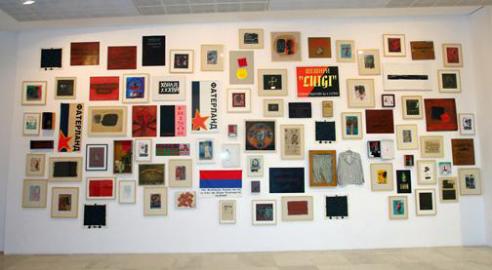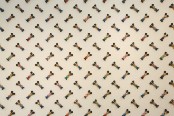
Serbian Pavilion 2011
54th International Art Exhibition – La Biennale di Venezia
Raša Todosijević:
Light and Darkness of Symbols
Commissioner: Živko Grozdanić
Official opening: June 2 at 4:15pm
June 4 - November 27, 2011
email:
info@msuv.org
Contacts
Museum of Contemporary Art Vojvodina in Novi Sad
Dunavska 37, Novi Sad, Serbia
T/F: +381 21 526 634
E:
info@msuv.org
www.msuv.org
www.pavilionserbia.org
Members of the Professional Council – Irina Subotid (President), Jerko Denegri, Mrđan Bajid, Zoran Todorovid and Zoran Erid, have decided that Serbia's representative on the 54th Venice Biennale of Contemporary Art will be Dragoljub Raša Todosijevid with his project Light and Darkness of Symbols. Museum of Contemporary Art Vojvodina will carry out the participation of the selected representative, the exhibition curator is Sanja Kojic Mladenov, while its Commissioner is Zivko Grozdanic.
The title of the 54th International Art Exhibition of La Biennale di Venezia is: ILLUMInations.
La Biennale di Venezia represents one of the most important and influential forums for the dissemination and ''illumination'' of current developments and movements on the international art scene. Therefore, the starting point and the concept of this year's Venice Biennale artistic director, Swiss art historian, critic and curator, Bice Curiger, is a historical reference to the work of Venetian painter Tintoretto, whose occupation with light, either rational or transcendental, can be viewed as significant for the work of many contemporary artists. Accordingly, the National Participations were invited to represent their countries in pavilions through the work of artists dealing with questions related to the central exhibition theme – ILLUMInations.
Through the issue of symbols, the project of the Belgrade conceptual artist Rasa Todosijevid is engaged in observation and ''clarification'' of sociopolitical, economic and cultural context of the author's social environment, with special focus on sensitive issues such as mythology, religion and power. The Project Light and Darkness of Symbols is composed of several segments, conceptualized through the different forms of installations, journal, and history.
At 54th Venice Biennale, Todosijevid will present the exhibition in three interdependent parts.
The first part of the exhibition refers to the works under the title ''Journal,'' which represent the sum of 120 smaller works produced in different materials, with different conceptual approaches and in different dimensions. Each individual art piece can be displayed and interpreted as a separate artistic entity. Designed in this way, the ''Journal'' is a constantly supplemented and growing unit with changing variables and relations where each piece is complete and independent. Therefore, these are not drafts, but conceptually compose a larger piece.
The first version of ''Journal'' was exhibited at the Gallery Remont in Belgrade, the second at the retrospective exhibition of Todosijevid's works at the Museum of Contemporary Art in Belgrade, and the third at the retrospective exhibition at the Gallery of Contemporary Art Celje in Slovenia. Furthermore, the fourth was a retrospective exhibition at the National Gallery for Foreign Art in Sofia, the fifth an independent exhibition at the Gallery Ozone in Belgrade, the sixth version was on the 50th October Salon in Belgrade, while the seventh was presented at a recently held exhibition entitled ''Serbia – Frequently Asked Questions'' in the gallery of the Austrian Cultural Forum New York.
The second part of Todosijevid's exhibition at the 54th Venice Biennial will be the work entitled ''Installations''.
The one part of the exhibition 'Installations'' will consist the works borrowed from the existing art collections and pieces which have also been produced before, but in a way that allows further expansion, refinement or extensions – for instance, the piece entitled ''The Sculpture'' which consists of fifty teapots filled with cement. This piece is a part of a series of works in which Todosijevid constantly discusses some of the inherited conceptions and understandings of the Art.
The series entitled ''Installations of Grand Piano or Upright Piano'' - keyboards pierced by canes - will also be exhibited at the 54th Venice Biennial. These pieces are subordinated to the idea which, among other things, brings into the question the meaning of the term ''traditional materials''. Stabbed pianos were made of the so-called classic materials, classic instruments and archaic canes, that symbolize age and infirmity, as well as patriarchy, the leader, leadership, power...
The exhibition also includes a series of installations collectively entitled ''Gott liebt die Serben'' (God Loves the Serbs) which, in fact, denote the debate about the constantly changing interpretation of symbols and conditionality of these changes in given historical circumstances.
The third part of the exhibition consists of photographs, representing a kind of historical introduction, preface, or retrospective summary of artist's arrival to the forms of Installations, Journal, Piano, Sculptures... These are the photographs of those Todosijevidʹs works that represent an imposing support of his artistic work and activities, which, as the artist said himself, helped him create his present and allowed him to be who he is.
Conceptually, these artworks represent mainly recordings of Todosijevidʹs performances from the early seventies, such as Decision as Art, Drinking Water, Was ist Kunt – What is Art?; billboards from the Nineties (Murder, Serboranges, Sewage Flower, The Best Wine in Italy, Art is Dead...) and billboards from the end of the first decade of 21st century (Tomorrow is Monday, Mother for Sale, Despite the Economic Crisis…).
An extensive exhibition catalog will present reproductions of many earlier works of Dragoljub Raša Todosijevid and provide detailed provenance and exhibition histories of each work, as well as artist's biography and professional texts.
Raša Todosijevid's selected project will be exhibited in the Pavilion ''Yugoslavia'' from June 4th until November 27th, 2011.
Commissioner
Ivko Grozdanid
E:
zivkogrozdanic@yahoo.com
Curator
Sanja Kojid Mladenov
E:
sanjamladenov@gmail.com
Secretary
Ljubica Milovid
M: +381648550923
M: +381 63312052
E:
ljubica.milovic@msuv.org
Press and Public Relations Danijela Halda
M: +381648550921 M: +381 638935217
E: info@msuv.org
E:
danijela@msuv.org
Artist's Biography
Dragoljub Raša Todosijevid Dragoljub Raša Todosijevid was born on 2 September 1945, in Belgrade, Serbia. He graduated at the Academy of Fine Arts in Belgrade, in 1969. He works and lives in Belgrade, Serbia. Todosijevid is one of the key protagonists of the circle of Belgrade conceptual artists. In the late 1960s and early 1970s, he had made radical steps away from the ideology and practice of socialist modernism, taking part in the new movements that were emerging on the world scene. Together with his colleagues (Marina Abramovid, Era Milivojevid, Neša Paripovid, Zoran Popovid and Gergelj Urkom) gathering in the Student Cultural Center in Belgrade, he contributed to the affirmation of the so called New Artistic Practice throughout the territory of former Yugoslavia, and profoundly influenced many contemporary artists. His work is intensely imbued with political and social criticism, through constant questioning and reexamining of traditional cultural and art systems, as well as society, as a whole. The art practice of Dragoljub Raša Todosijevid is directed towards research in various media and techniques, from performances, actions, video works, three-dimensional installations, to the problematizing of the medium of painting and the practice of painting, itself. Some of his most prominent works are “Decision as Art”, “Was ist Kunst?” (“What is Art?”), “Gott liebt die Serben” (“God Loves the Serbs”), “My Fuxus Pianos”, and many others. Todosijevid's performance is marked by a provocative and aggressive behavior with which he irritates the negative in a person in order to draw attention to that particular problem, as in the works “Was ist Kunst?”, “Vive la France-vive la tyrannie, “Decision as Art”, and so on. During the mid-1970s, he performed a series of drawings under the common title “No a day without a line” (“Nulla dies sine linea”). Applying consequently or dogmatically this well-known proverb in various galleries and museums, he was trying to demystify the act of art, itself, connecting it, ironically, with an act of labor and “training of the hand”, and the context of presentation of artworks. In the 1970s, he also produced numerous collages through which he examined authority and authorship in the art world. In the 1990s, Todosijevid used advertising media, such as newspapers, posters, billboards and radio, starting a series of pseudo-ads and pseudo-advertisements, featuring a fictitious art academy “Todosijevid”, a fictitious Kvass corporation Todosiyevitch-Malevich, etc. Through a cycle of installations, drawings, and sculpture he entitled “Gott liebt die Serben”, which started in 1989, Todosijevid ironized nationalistic kitsch, pushing it to the extreme, as he did in Belgrade and Čačak, in 1998, when he served Serbian national specialties- bean broth, bread and beer at tables set up to form the shape of a swastika. From the year 2000 he continues to undertake actions titled “A Mother For Sale” in urban environments- on billboards, buses, trams etc.
Todosijevid also writes theoretical texts, fine art criticism, and stories, such as: “For Art- and Against Art” (Belgrade 1974), “The Edinburgh Statement - Who makes a profit on Art, And who gains from it honestly?” (Belgrade 1975), “What Lines Are” (Belgrade 1977), “Art As Criticism of Society”, “Art and Revolution”, which he publishes in catalogues and trade publications. He is an author of a number of books of stories on art. Dragoljub Raša Todosijevid has exhibited at numerous solo and group exhibitions, in prestigious galleries and museums throughout the world. He is the recipient of the ArtsLink 2004 Award, IASPIS Residential Award 2001, in Stockholm, and the 2006 Emily Harvey Foundation Award in New York -Venice. He also received the 50th October Salon Award in Belgrade, as well as the 2009 “Politika” Award in Serbia.
More info at:
http://www.pavilionserbia.org



